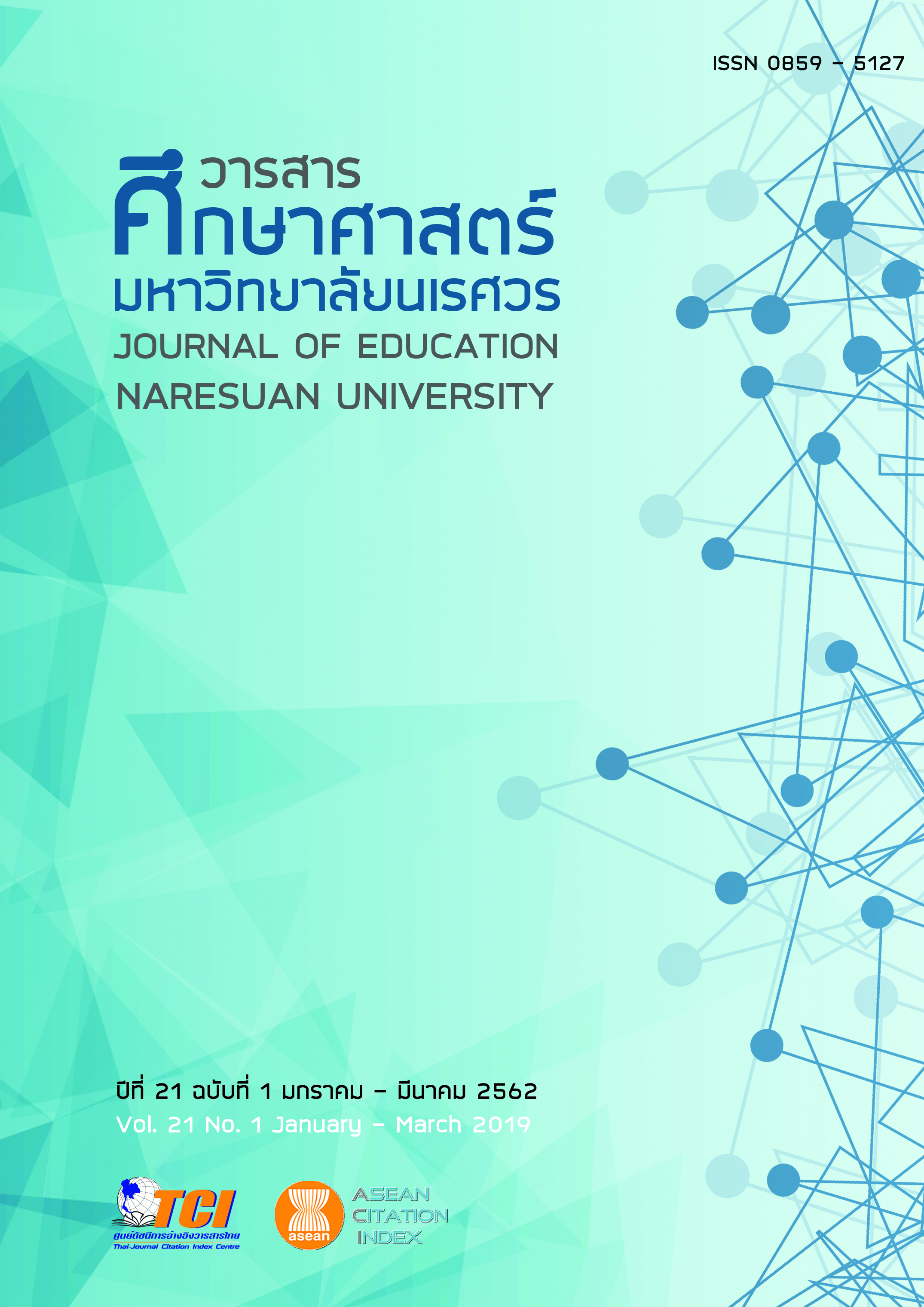การพัฒนาชุดการเรียนรู้คณิตศาสตร์เพื่อส่งเสริมจิตคณิตศาสตร์ของนักเรียนที่มีความสามารถพิเศษระดับประถมศึกษา (A DEVELOPMENT OF MATHEMATICS EXPLORING PACKAGE FOR ENHANCING MATHEMATICAL MINDS OF GIFTED STUDENTS AT THE ELEMENTARY LEVEL)
Main Article Content
Abstract
การวิจัยครั้งมีวัตถุประสงค์เพื่อสร้างชุดการเรียนรู้คณิตศาสตร์สำหรับส่งเสริมจิตคณิตศาสตร์ของนักเรียนที่มีความสามารถพิเศษที่มีประสิทธิภาพ และศึกษาเปรียบเทียบจิตคณิตศาสตร์ของนักเรียนก่อนและหลังใช้ชุดการเรียนรู้ และความพึงพอใจของนักเรียนที่มีต่อการใช้ชุดการเรียนรู้คณิตศาสตร์ โดยกลุ่มตัวอย่างของงานวิจัยครั้งนี้เป็นนักเรียนที่มีความสามารถพิเศษด้านคณิตศาสตร์ที่กำลังศึกษาชั้นประถมศึกษาปีที่ 1 ถึง 3 จำนวน 28 คน ซึ่งเป็นผู้ที่ผ่านการประเมินโดยโครงการวินิจฉัยศักยภาพครบวงจร มหาวิทยาลัยศรีนครินทรวิโรฒ เครื่องมือที่ใช้ในการวิจัยครั้งนี้ ประกอบด้วย 1) ชุดการเรียนรู้คณิตศาสตร์ (Math Exploring package) 2) แบบประเมินคุณภาพชุดการเรียนรู้ 3) แบบทดสอบจิตคณิตศาสตร์ และ 4) แบบประเมินความพึงพอใจของนักเรียนที่มีต่อการใช้ชุด
การเรียนรู้วิเคราะห์ข้อมูลโดยใช้ค่าเฉลี่ย การทดสอบที (t-test) แบบ Dependent sample และวิเคราะห์เนื้อหา ผลการวิจัย พบว่า ชุดการเรียนรู้คณิตศาสตร์ที่พัฒนาขึ้นมีค่าประสิทธิภาพ 84.50/82.58 ซึ่งเป็นไปตามเกณฑ์ 80/80 เมื่อนักเรียนใช้แล้วมีพัฒนาการด้านจิตคณิตศาสตร์หลังเรียนสูงกว่าก่อนเรียนอย่างมีนัยสำคัญทางสถิติที่ระดับ .05 และนักเรียนมีความพึงพอใจต่อการใช้ชุดการเรียนรู้คณิตศาสตร์โดยภาพรวมอยู่ในระดับมากที่สุด
A DEVELOPMENT OF MATHEMATICS EXPLORING PACKAGE FOR ENHANCING MATHEMATICAL MINDS OF GIFTED STUDENTS AT THE ELEMENTARY LEVEL
This research aimed to construct an effective Math Exploring (MathEX) Package to enhance mathematical minds and to compare the students’ mathematical minds before and after learning by MathEx and their satisfaction after learning through using MathEX package. The participants of the research were 28 students who were identified as mathematical gifted students from gifted program at Srinakharinwirot University. Research tools were 1) MathEX Package to enhance Mathematical minds, 2) the questionnaire developed to assess the quality of MathEX Package, 3) Mathematical minds test, and 4) the questionnaire to investigate students’ satisfaction. The data were analyzed using mean, dependent sample t-test and content analysis. The results showed that efficiency of MathEX Package that researcher had developed was 84.50/82.58 and higher than criterion 80/80, mathematical minds of the students using the MathEX Package had the significantly higher post-test score than the pre-test score at the level of .05 and the overall students satisfaction after using the MathEX was excellent.
Article Details
The owner of the article does not copy or violate any of its copyright. If any copyright infringement occurs or prosecution, in any case, the Editorial Board is not involved in all the rights to the owner of the article to be performed.
References
Betts, G. T., & Neihart, M. (2010). Revised profiles of the gifted & talented. Retrieved from https://www.det.act.gov.au/_data/assets/pdf_file/0009/587304/Gifted-Underachievers.pdf
Clark, Barbara. (2012). Growing up gifted: Developing the potential of children at home and at school (8th ed.). Boston: Pearson.
Geary, D. C., & Brown, S. C. (1991). Cognitive addition: Strategy choice and speed of processing differences in gifted, normal, and mathematically disabled children. Developmental Psychology, 27(3), 398-406.
Gould, S. L. (2001). The value of science: essential writings of Henri Poincare. New York: Dover.
Harnkajornsuk, S. (2014). Instruction manual: SPE 641 Education for the gifted and talented. Bangkok: The research and development institute for special education, Srinakharinwirot University. [in Thai]
Kanjanasena, P., Thongjaem, P., & Naowarat, S. (2016). The development of learning packages on equations and solving equations for Prathomsuksa VI students. Journal of Education Mahasarakham University, 10(2), 71-82. [in Thai]
Koocharoenpisal, N., Butnian, N., Jaroensiri, N., & Somjaroen, W. (2016). The effect of utilizing the problem-based learning activity packages on pollution for lower secondary students. Journal of Education Naresuan University, 18(4), 40-55. [in Thai]
Miller, R. C. (1990). Discovering mathematical talent. Reston, VA: Council for Exceptional Children. (ERIC Document Reproduction Service No. ED 321487).
Reis, S. M., Westberg, K. L., Kulikowich, J., Caillard, F., Hébert, T., Plucker, J., . . . Smist, J. M. (1993). Why not let high ability students start school in January? The curriculum compacting study (Research Monograph 93106). Storrs: University of Connecticut, The National Research Center on the Gifted and Talented.
Rogers, K. B. (2002). Re-forming gifted education: How parents and teachers can match the program to the child. Scottsdale, AZ: Great Potential Press.
Sak, U. (2009). Test of the Three-Mathematical Minds (M3) for the identification of mathematically gifted students. Roeper Review, 31(1), 53-67.
Sheffield, L. J. (1994). The development of gifted and talented mathematics students and the National Council of Teachers of Mathematics standards. Storrs, Connecticut: National Research Center on the Gifted and Talented.
Sternberg, R. J. (2000). Patterns of giftedness: A tribrachic analysis. Roeper Review, 22(4), 231-235.
Winner, E. (1997). Exceptionally high intelligence and schooling. American Psychologist, 52, 1070-81.

